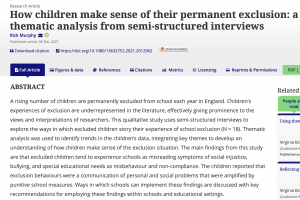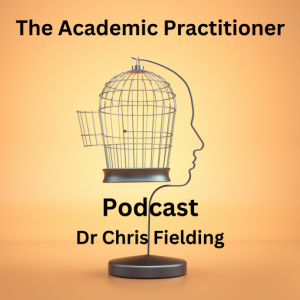The majority of the children enter our centre having either been permanently excluded from primary school or have been moved because they are very close to that point. The children sometimes tell us about their experiences of exclusion but in the academic literature, the voice of permanently excluded pupils is not often heard.
Ricky Murphy 1(2021) interviewed 18 permanently excluded pupils (aged 6-16) and uses their stories to discuss the themes that emerged. As the head of a centre which receives excluded children, none are a surprise and I would recommend following the link to his open access article and spending some time reading their words. They are hard hitting.
Murphy conducted semi-structured interviews with children from 4 different alternative provisions. All had been permanently excluded from school at least once. Most pupils reported being physically or emotionally abused in the past. Almost all the pupils had a learning difficulty in addition to complex home lives and the majority had been subject to bullying at school.
The majority of pupils in our centre have some form of learning difficulty on top of all the other challenges that they face. Most have struggled to keep up with the academic pace of mainstream primary education. One main theme emerging from Murphy’s interviews was the way in which the children storied their academic experience. Children struggling to keep up in lessons do not do so in a vacuum, they struggle in a very public space and in the midst of a complex social environment. The majority of pupils Murphy interviewed also had some form of learning difficulty and they were each trying to cope with the daily experience of very visibly being an academically struggling pupil. In this public space, for some pupils, highlighting the learning need was more problematic than the learning need itself and the punitive experience of exclusion was less weighty than the ‘punitive social experience of being ‘stupid”.
On a first visit to our centre, a recently excluded child with a significant learning disability asked me ‘Do you have bullies at the Forwards Centre?’ I could hear the anxiety in his voice and answered as honestly as I could with ‘No…but we do have lots of children who have been bullied’. Almost all the pupils Murphy interviewed related stories of bullying at around the time of their exclusion. Most were experiencing challenges in their lives and Murphy found that the ‘exclusion- behaviour is repeatedly linked to how their personal problem stood out in the social context’. The challenges that they were facing made them stand out from their peers. Pupils said that the problems they were facing were difficult. They were also being mocked and ridiculed about the challenges they were facing. One child described her father becoming ill and dying of cancer. Other pupils ridiculed this and set up fake social media accounts to mock her. Ultimately, she threw a chair at one of those bullying her and was permanently excluded from school. It may be that her challenging behaviour was a coping mechanism used to protect herself. She had tried speaking to staff and the option for flight had been removed as she was required to attend and be in the same room as those publically laughing at her father’s illness and death. ‘Fight’ may have been the only option left to her in an attempt make the bullying go away.
Before taking up the headship of our setting, I worked for many years in mainstream education and was the head of two primary schools. I understand the pressures of the curriculum and the requirement to move a whole cohort of children through an academic programme of work. It is relentless and for a small group of pupils facing multiple challenges in their lives, it may not be appropriate and their behaviour reflects being placed in this environment. Murphy discusses institutional inequalities in the education system where schools are simply an extension of the state. Murphy believes that there is a context of racial, social and disability discrimination where children bring ‘multiple social and educational inequalities into the school environment’ and ‘these inequalities are hidden beneath layers of challenging behaviour’. The danger is that challenging behaviour is seen intrinsic to the child rather than a symptom or coping mechanism related to underlying risk factors in their life. One of the main findings of his study is that ‘excluded children tend to experience school as misreading symptoms of social injustice, bullying and special educational needs as misbehaviour and non-compliance’. I find myself in agreement with that.
In our centre, we also worry about primary aged children dropping out of their social world and becoming detached from their communities as a result of their exclusion. Murphy felt the same. Excluded pupils are no longer allowed to attend their school and are transported out of their community each day to be educated elsewhere. Schools are the centre of local communities and children soon lose touch with their friends and this seems to be long lasting. In the study, almost all pupils reported becoming isolated from the peers following their exclusion and that this was still the case. Murphy found a worrying trend where even in the age of social media, ‘young people tended to be alone for most evenings and weekends and described their lives as ‘boring’ or ‘lonely”.
This is a small scale study, including only 18 pupils from 4 settings, however the words of the children ring true. We have an education system that is set up for the majority. Through no fault of their own, some children face multiple challenges in their lives and this means that they stand out. Standing out makes them vulnerable and children cope the best way they can. Tackling some of the underlying challenges that a child faces may be a long haul and take a lot of time. Whilst that is going on, if we choose to continually place them an academically charged public space where their learning difficulty makes them stand out even more then that is our choice as professionals and the resultant behaviour is down to us. Good quality alternative provision lifts children out of that environment for a period of time and we see children slowly become comfortable in their own skin and engage with learning at a pace they can handle and from the point they are at. The need for maladaptive coping mechanisms diminishes and their behaviour becomes settled. It is deeply worrying that many children have to go through a punitive exclusion route to get there.
Each month I will send out the way that the latest research and practice impacts on children excluded from school. Sign up below and let me know if you think something needs to be included – Chris


